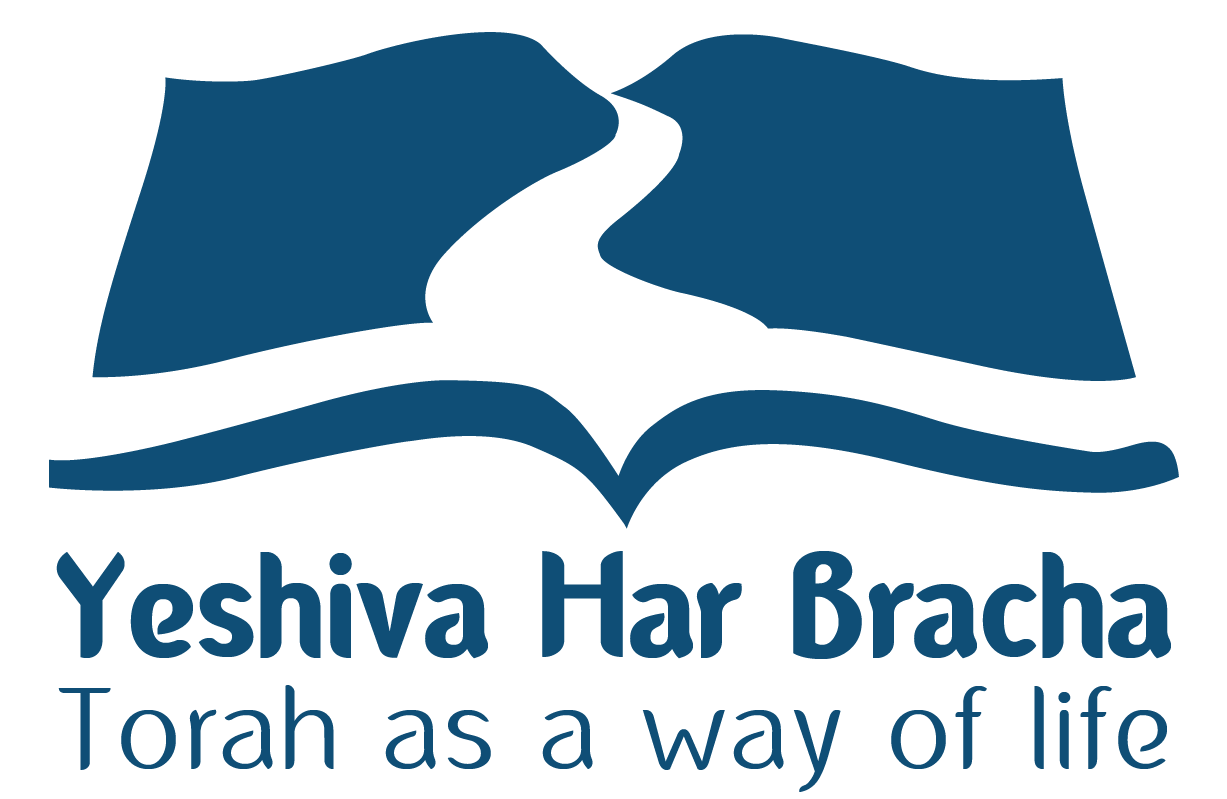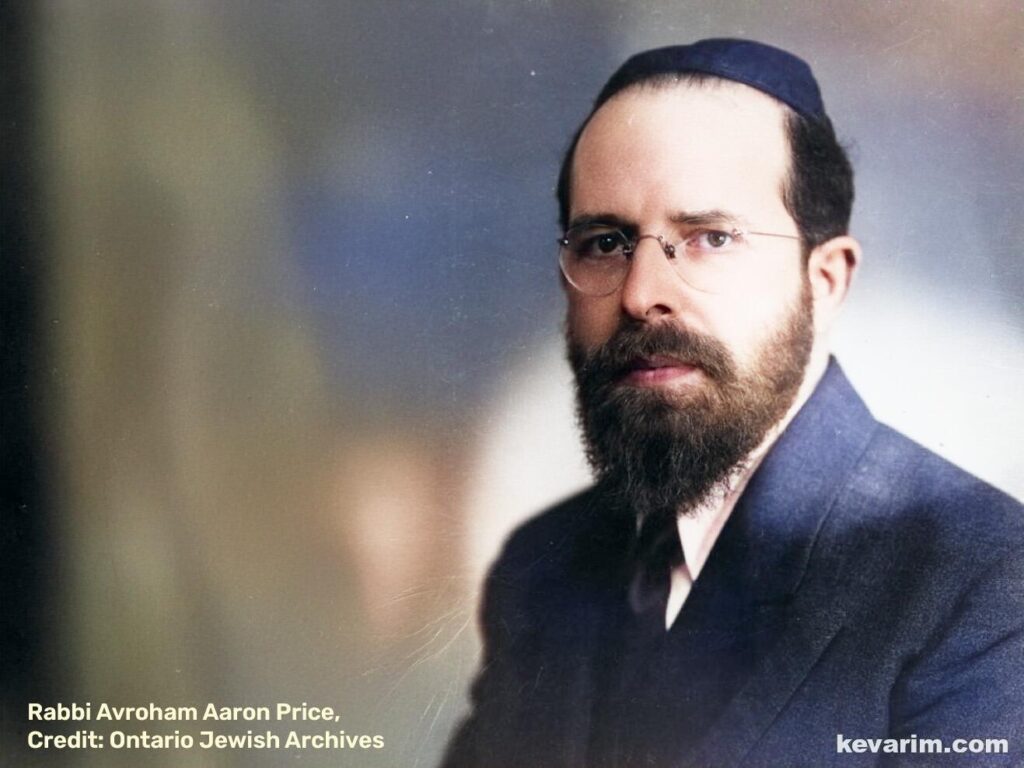A Glimpse into the Life of Rabbi Avraham Price Ztz”l The unique entrance exam conducted for the young boy by the Avnei Nezer ● Ordained as a rabbi at just 18 ● To earn his livelihood, he invested in real estate, amassed wealth, and eventually opened his own bank ● When the Nazis rose to power, he was forced to flee suddenly, leaving all his possessions behind ● In 1937 (5697), at age 36, he accepted the offer of Toronto’s “Chevra Shas” community to serve as their rabbi and establish a yeshiva for boys ● He headed the “Torat Chaim” Yeshiva for 38 years and continued to serve as head of the Toronto Rabbinical Court until his passing
Recent Arrival of His Books in Har Bracha
In recent weeks, a large shipment of the writings of the late Rabbi Avraham Aharon Price, Mishnat Avraham, arrived from Canada to Har Bracha, thanks to the help of Mr. David Wallerstein, the uncle of Rabbi Maor Kayam, head of the Har Bracha Institute. Before telling how the books arrived, let us share a bit about Rabbi Price’s life (1900–1994).
Early Life
Rabbi Avraham Aharon Price was born in 1900 (5660) in Pińczów, a small town in Poland, into a family of seven children. His brilliance was evident from childhood. By age nine he was studying under Rabbi Moshe Nachum Yerushalmsky of Kielce, author of Leshad HaShemen on Maimonides.
His father had studied under the great Rabbi Avraham Bornsztain, the Avnei Nezer, Rebbe of Sochaczew. When young Avraham was nine, his father brought him to the Avnei Nezer’s renowned yeshiva. The Rebbe was astonished to see such a young child and said he would only accept him after a test. He told the boy, “I will tell you a Talmudic argument; you must repeat it and tell me whether it is correct.”
After presenting the argument, the Rebbe asked the father, “Is my reasoning good?” The father said, “Yes, it is.” The Avnei Nezer then asked the boy, “And what do you think?” The child replied, “It’s not good.” The Rebbe asked, “What’s wrong with it?” The boy answered, “In the middle, you connected two things that don’t really fit.” The Avnei Nezer smiled and said, “That’s exactly what I wanted to hear,” and accepted him into the yeshiva.
A year later the Avnei Nezer passed away, but in that short time the young prodigy absorbed his method of deep, intricate study.
One day, when Rabbi Yoav Yehoshua Weingarten (Chelek Yoav) visited the Avnei Nezer, he asked the boy, “What must a rabbi know?” The child answered, “Writing, ritual slaughter, and circumcision.” The guest asked, “What else?” The boy added, “The laws of betrothal and some other important areas.” The rabbi pressed again: “And what more?” The boy finally said, “A rabbi must know how to learn.” The Chelek Yoav greatly enjoyed the answer, laughing so hard that his whole body shook — a story Rabbi Price often retold to emphasize the value of true scholarship.
By 1916 (age 15) he was living in Chełmno, serving Rabbi Avraham Yitzchak Silman, a disciple of Rabbi Tzadok HaKohen of Lublin. In 1919 (age 18), he received rabbinic ordination from Rabbi Silman and married. He had a son and a daughter, but the marriage did not last; they divorced, and his son later perished in the Warsaw Ghetto Uprising.
Business and Torah in Berlin
In 1923, at age 23, Rabbi Price moved to modern Berlin. A follower of the Gur Hasidic dynasty, he exemplified the Polish Hasidic model of a Torah scholar who also worked for a living. He began investing in real estate, accumulated wealth, and eventually opened and managed his own bank. Alongside his business, he delivered daily Torah lectures in Berlin synagogues.
During those years he met the renowned Rabbi Chaim Heller, a scholar who combined Talmudic erudition with academic study. Rabbi Price became his student. Rabbi Heller founded an advanced rabbinical seminary in Berlin, attracting students such as Rabbi Joseph B. Soloveitchik and Rabbi Menachem Mendel Schneerson, later the Lubavitcher Rebbe. Rabbi Price often shared Rabbi Heller’s Torah insights and stories throughout his life.
Flight to Paris and Immigration to Canada
After about ten years in Germany, as the Nazis rose to power, Rabbi Price had to flee abruptly, leaving everything behind. One morning a non-Jewish client warned him not to go to his bank — “the Nazis are looking for you.” He escaped by the skin of his teeth to France, penniless.
In Paris, he tried to find a rabbinic position but failed. He endured hunger, cold, and poverty, yet continued to study tirelessly, later saying that some of his greatest Torah insights were written in those harsh days. Eventually he sought a position in North America, receiving an offer from the “Chevra Shas” community in Toronto, which had about 20,000 Jews at the time.
In 1937, at age 36, he arrived in Toronto and married Rebbetzin Sarah (née Wain). They had no children together, but his daughter from his first marriage later joined him in Canada, and his descendants came from her.
The “Torat Chaim” Yeshiva
Rabbi Price’s yeshiva in Toronto was called Torat Chaim. His mission was to raise Torah scholars and rabbis, and over time the institution expanded to include older students. In 1941, he ordained three graduates as rabbis, including Rabbi Gedalia Felder, later a leading Toronto rabbi and author of Yesodei Yeshurun.
During the war, in 1941, young Jewish refugees with German citizenship were interned in Canada as possible “enemy aliens.” Rabbi Price realized that antisemitism, not security concerns, was behind this. He met with Mr. Blair, head of Immigration, in Ottawa and argued that these yeshiva students would “strengthen Canada’s religious life.” His reasoning persuaded Mr. Blair, who released them.
Rabbi Price went to the detention camps, gathered the yeshiva boys, and brought over fifty of them to his yeshiva in Toronto — an event that deeply moved the Jewish community. He provided for all their needs, and after the war, he brought fifty-five more students from Europe. The yeshiva grew to nearly 300 students.
As an Educator
Despite his brilliance, Rabbi Price had a gift for simplifying complex ideas so that even boys from modest backgrounds could understand. He was sharp and critical but deeply caring. His rebukes were often witty — for instance, when asked for feedback on a sermon, he once replied, “Not bad, compared to most sermons — though nothing compares to saying nothing at all.”
His yeshiva’s program focused purely on Torah study without secular subjects. When someone reported that some students had gone on outings with girls to a nearby island, Rabbi Price asked, “Do public-school boys also go there?” The informer said, “Yes, but they’re not yeshiva students.” Rabbi Price responded, “So you’re saying their sin is not going to the island — everyone goes there — but that they’re yeshiva boys. For such a sin, I can forgive them.”
He would ask graduates whether they wanted to continue toward rabbinic ordination or enter professional life. Those who chose careers were encouraged to attend university — a rare stance for Orthodox rabbis at the time. “To succeed,” he would say, “one needs an academic degree.” His students — rabbis and professionals alike — spread throughout Canada, strengthening Torah and faith in many communities.
Rabbinic Leadership in Toronto
When Rabbi Price arrived, the city’s chief rabbi and head of the Rabbinical Court was Rabbi Yehuda Leib Graubart, author of Chavalim Bane’imim, about 40 years his senior. After Rabbi Graubart’s death that same year, Rabbi Price became Toronto’s leading rabbinic figure. He established a kashrut organization, arranged an eruv, officiated at marriages and divorces, and was recognized as the head of Toronto’s Beit Din.
He was well-versed in medieval Jewish philosophy, often quoting Judah Halevi and Maimonides in his sermons. When a zealot once threatened to cut the wires of the city’s eruv, Rabbi Price retorted: “Go ahead — then we’ll fulfill the verse ‘and you shall remove the evil from your midst.’”
Financial and Intellectual Independence
Even in Toronto, Rabbi Price wished to remain financially independent and not rely on a salary. Though he had lost his fortune fleeing Germany, he resumed real estate ventures and became wealthy again. His student Rabbi Avraham Kalman said: “He became a great man of means — in him, Torah and greatness truly met.”
His wife managed the day-to-day business, while he made major decisions — easily shifting from worldly affairs to deep Torah study and writing.
He insisted on independence: unlike many rabbis, dependent on their congregations, Rabbi Price wanted no such reliance. He accepted a salary from “Chevra Shas,” but deposited it into a fund — “The Rabbi Price Fund” — from which he gave stipends to Torah students traveling to study in Israel.
Final Years
Rabbi Price headed the Torat Chaim Yeshiva for 38 years (1937–1975) and served as head of the Toronto Beit Din for 57 years, until his passing on Thursday, the third day of Chol HaMoed Pesach, 1994 (5754).
In his later years, he devoted most of his time to writing his Torah works, telling his students that his time was precious and dedicated to his writings.
My son-in-law, Rabbi Avishai Laks, who served as a rabbi and emissary in Toronto for the past three years, assisted me in writing this column. In the next column, I will discuss Rabbi Price’s teachings and how his books arrived in Har Bracha.
This article appears in the ‘Besheva’ newspaper and was translated from Hebrew.








